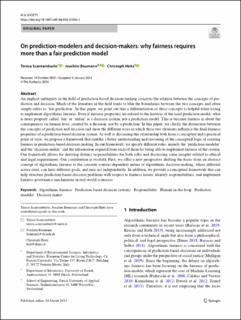Please use this identifier to cite or link to this item:
https://doi.org/10.21256/zhaw-30423Full metadata record
| DC Field | Value | Language |
|---|---|---|
| dc.contributor.author | Scantamburlo, Teresa | - |
| dc.contributor.author | Baumann, Joachim | - |
| dc.contributor.author | Heitz, Christoph | - |
| dc.date.accessioned | 2024-04-06T09:38:57Z | - |
| dc.date.available | 2024-04-06T09:38:57Z | - |
| dc.date.issued | 2024-03-16 | - |
| dc.identifier.issn | 0951-5666 | de_CH |
| dc.identifier.issn | 1435-5655 | de_CH |
| dc.identifier.uri | https://digitalcollection.zhaw.ch/handle/11475/30423 | - |
| dc.description.abstract | An implicit ambiguity in the field of prediction-based decision-making concerns the relation between the concepts of prediction and decision. Much of the literature in the field tends to blur the boundaries between the two concepts and often simply refers to ‘fair prediction’. In this paper, we point out that a differentiation of these concepts is helpful when trying to implement algorithmic fairness. Even if fairness properties are related to the features of the used prediction model, what is more properly called ‘fair’ or ‘unfair’ is a decision system, not a prediction model. This is because fairness is about the consequences on human lives, created by a decision, not by a prediction. In this paper, we clarify the distinction between the concepts of prediction and decision and show the different ways in which these two elements influence the final fairness properties of a prediction-based decision system. As well as discussing this relationship both from a conceptual and a practical point of view, we propose a framework that enables a better understanding and reasoning of the conceptual logic of creating fairness in prediction-based decision-making. In our framework, we specify different roles, namely the ‘prediction-modeler’ and the ‘decision-maker,’ and the information required from each of them for being able to implement fairness of the system. Our framework allows for deriving distinct responsibilities for both roles and discussing some insights related to ethical and legal requirements. Our contribution is twofold. First, we offer a new perspective shifting the focus from an abstract concept of algorithmic fairness to the concrete context-dependent nature of algorithmic decision-making, where different actors exist, can have different goals, and may act independently. In addition, we provide a conceptual framework that can help structure prediction-based decision problems with respect to fairness issues, identify responsibilities, and implement fairness governance mechanisms in real-world scenarios. | de_CH |
| dc.language.iso | en | de_CH |
| dc.publisher | Springer | de_CH |
| dc.relation.ispartof | AI & Society | de_CH |
| dc.rights | https://creativecommons.org/licenses/by/4.0/ | de_CH |
| dc.subject | Prediction-based decision making | de_CH |
| dc.subject | Fair prediction | de_CH |
| dc.subject | Algorithmic fairness | de_CH |
| dc.subject | Responsible AI | de_CH |
| dc.subject | Human-in-the-loop | de_CH |
| dc.subject | Prediction modeler | de_CH |
| dc.subject | Responsibility | de_CH |
| dc.subject.ddc | 006: Spezielle Computerverfahren | de_CH |
| dc.subject.ddc | 170: Ethik | de_CH |
| dc.title | On prediction-modelers and decision-makers : why fairness requires more than a fair prediction model | de_CH |
| dc.type | Beitrag in wissenschaftlicher Zeitschrift | de_CH |
| dcterms.type | Text | de_CH |
| zhaw.departement | School of Engineering | de_CH |
| zhaw.organisationalunit | Institut für Datenanalyse und Prozessdesign (IDP) | de_CH |
| dc.identifier.doi | 10.1007/s00146-024-01886-3 | de_CH |
| dc.identifier.doi | 10.21256/zhaw-30423 | - |
| zhaw.funding.eu | No | de_CH |
| zhaw.originated.zhaw | Yes | de_CH |
| zhaw.publication.status | publishedVersion | de_CH |
| zhaw.publication.review | Peer review (Publikation) | de_CH |
| zhaw.funding.snf | 187473 | de_CH |
| zhaw.webfeed | Datalab | de_CH |
| zhaw.webfeed | Predictive Analytics | de_CH |
| zhaw.funding.zhaw | Socially acceptable AI and fairness trade-offs in predictive analytics | de_CH |
| zhaw.author.additional | No | de_CH |
| zhaw.display.portrait | Yes | de_CH |
| Appears in collections: | Publikationen School of Engineering | |
Files in This Item:
| File | Description | Size | Format | |
|---|---|---|---|---|
| 2024_Scantamburlo-etal_On-predicition-modelers-decision-makers_aisoc.pdf | 1.05 MB | Adobe PDF |  View/Open |
Show simple item record
Scantamburlo, T., Baumann, J., & Heitz, C. (2024). On prediction-modelers and decision-makers : why fairness requires more than a fair prediction model. AI & Society. https://doi.org/10.1007/s00146-024-01886-3
Scantamburlo, T., Baumann, J. and Heitz, C. (2024) ‘On prediction-modelers and decision-makers : why fairness requires more than a fair prediction model’, AI & Society [Preprint]. Available at: https://doi.org/10.1007/s00146-024-01886-3.
T. Scantamburlo, J. Baumann, and C. Heitz, “On prediction-modelers and decision-makers : why fairness requires more than a fair prediction model,” AI & Society, Mar. 2024, doi: 10.1007/s00146-024-01886-3.
SCANTAMBURLO, Teresa, Joachim BAUMANN und Christoph HEITZ, 2024. On prediction-modelers and decision-makers : why fairness requires more than a fair prediction model. AI & Society. 16 März 2024. DOI 10.1007/s00146-024-01886-3
Scantamburlo, Teresa, Joachim Baumann, and Christoph Heitz. 2024. “On Prediction-Modelers and Decision-Makers : Why Fairness Requires More than a Fair Prediction Model.” AI & Society, March. https://doi.org/10.1007/s00146-024-01886-3.
Scantamburlo, Teresa, et al. “On Prediction-Modelers and Decision-Makers : Why Fairness Requires More than a Fair Prediction Model.” AI & Society, Mar. 2024, https://doi.org/10.1007/s00146-024-01886-3.
Items in DSpace are protected by copyright, with all rights reserved, unless otherwise indicated.